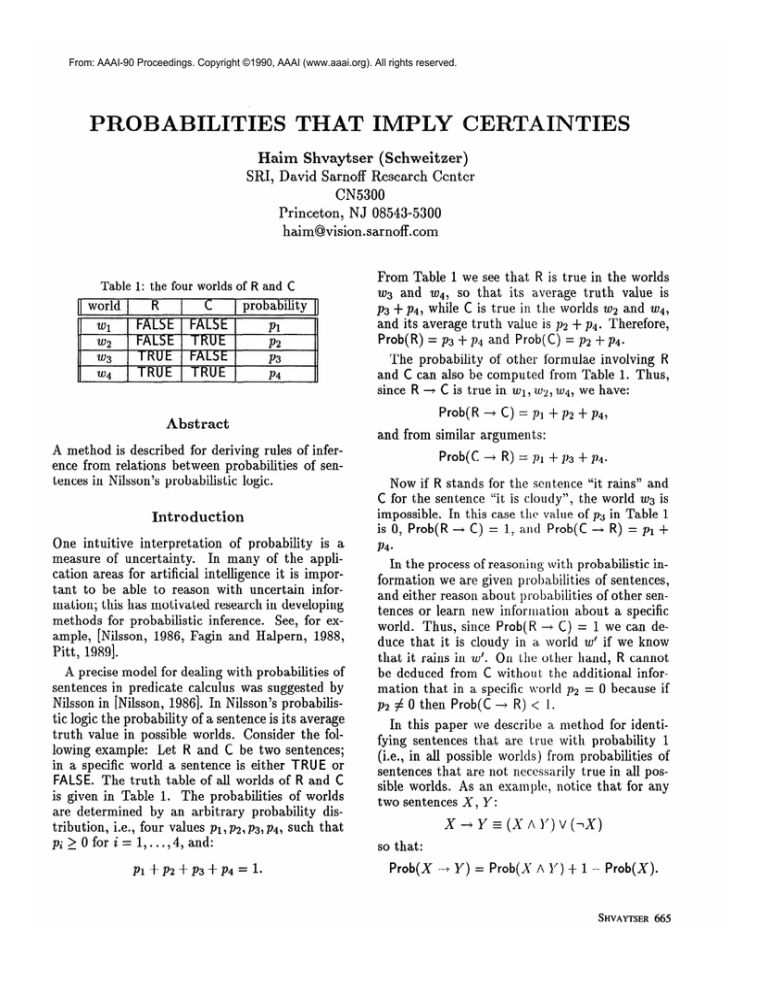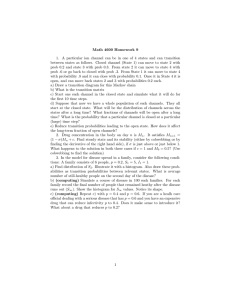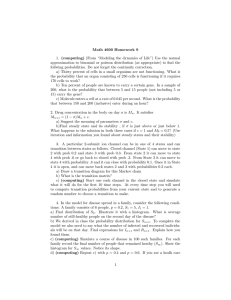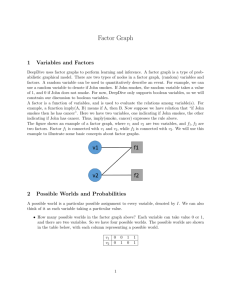
From: AAAI-90 Proceedings. Copyright ©1990, AAAI (www.aaai.org). All rights reserved.
ILITIES
CE
T
Haim Shvaytser
(Schweitzer)
SRI, David Sarnoff Research Center
CN5300
Princeton, NJ 08543-5300
haim@vision.sarnoff .com
Table 1: the four worlds of R and C
C
probability
world
R
Wl
FALSE
FALSE
From Table 1 we see that R is true in the worlds
w3 and ~4, so that its aaverage truth value is
p3 + p4, while C is true in the worlds wf~ and ~4,
and its average truth value is 112+ p4. Therefore,
Prob(R) = p3 + 134and Prob(C) = p2 + pd.
The probability
of other formulae involving
R
and C can also be computed from Table 1. Thus,
since R + C is true in wr , ~02, ~4, we have:
Prob( R -+ C) = pl + p2 -I- ~4,
Abstract
and from similar
A method is described for deriving rules of inference from relations between probabilities
of sentences in Nilsson’s probabilistic
logic.
Introduction
One intuitive
interpretation
of probability
is a
measure of uncertainty.
In many of the application areas for artificial intelligence
it is important to be able to reason with uncertain
information; this has motivated research in developing
methods for probabilistic
inference.
See, for example, [Nilsson, 1986, Fagin and Halpern, 1988,
Pitt, 19891.
A precise model for dealing with probabilities
of
sentences in predicate calculus was suggested by
Nilsson in [Nilsson, 19861. In Nilsson’s probabilistic logic the probability
of a sentence is its average
truth value in possible worlds. Consider the following example:
Let R and C be two sentences;
in a specific world a sentence is either TRU E or
FALSE. The truth table of all worlds of R and C
is given in Table 1. The probabilities
of worlds
are determined
by an arbitrary
probability
distribution,
i.e., four values pl,p2,p3,p4, such that
p; 2 Ofor i= 1,...,4,and:
Pl
+J%?+p3+p4
=
1.
arguments
:
Prob(C + R) = p1 + 119+ 134.
Now if R stands
C for the sentence
impossible.
In this
is 0, Prob( R -+ C)
for the sch tence “it rains” and
“it is cloudy”, the world w3 is
case the value of p3 in Table 1
= 1, ant1 Prob(C -+ R) = p1 +
P4.
In the process of reasoning with probabilistic
information we are given probabilities
of sentences,
and either reason about probabilities
of other sentences or learn new inforlnation
about a specific
world. Thus, since Prob(R --+ C) = 1 we can deduce that it is cloudy in a0 world 20’ if we know
that it rains in 20’. On the other hand, R cannot
be deduced from C without
the additional
information that in a specific Ivorld 112 = 0 because if
p2 # 0 then Prob(C --+ R) < I.
In this paper we describe a method for identifying sentences that are true with probability
1
(i.e., in all possible worlds) from probabilities
of
sentences that are not necessarily true in all possible worlds. As an example, notice that for any
two sentences X, Y:
x -+ Y s (X A Y) v (1X)
so that:
Prob(X + Y) = Prob(S A Y) + 1 - Prob(X).
SHVAYTSER
665
Prob(X + Y) = 1 if and only if
Specifically,
if it is
Prob(X A Y) = Prob(X).
known that, say, Prob( R) = 0.7 and Prob( R A C) =
0.7 then it must be that R + C in all possible
From Equation
worlds. This is a special
described in the paper.
Rules
Therefore,
case of results
that
are
The following definitions
of possible worlds and
probabilities
of sentences are the same as those
in [Nilsson, 19861.
Let &,...
, &, be n sentences in predicate calculus. A world is an assignment of truth values
&. There are 2n worlds; some of these
to h-1
worlds are possible worlds and the others are impossible worlds. A world is impossible if and only
if the truth assignment to 41, . . . , & is logically
inconsistent.
For example, if 42 = 141 then all
worlds with both 41 = TRUE and 42 = TRUE are
impossible.
We denote by PW the set of possible worlds. An
arbitrary
probability
distribution
D is associated
with PW such that a world w E PW has probability D(w) 2 0, and:
Let X,
If:
w-9.
(1)
A random variable X,,, is a function that has a
well defined (real) value in each possible world.
With a formula 4 we associate the random variable w( (b) that has the value of 1 in worlds where
4 is true and the value of 0 in worlds where 4 is
false. Equation
(1) can now be written as:
.
Definition:
variable X,
The expected
is:
l
D(w).
666 KNOWLEDGE
REPRJBENTATI~N
(2)
value of the random
E(X,)= x L -D(w).
UNGPW
variable
w(4)
in possible worlds
= xw
If there are coefficients
w($j) = C aijw(&)
i#j
then from
from C;+j
&j
CLijW(&)
of
and 4 a formula.
= 1 infer 4 and from
We investigate only a restricted
in which X, can be expressed
nation of the variables ~(4;):
X,
= 0
case of these rules
as a linear combi-
a;j such that:
in possible worlds
a;jw( 4;) = 1 infer
= 0 infer l$j.
~~ and
of this type linear rules
The main result of this paper is a method for
deriving a complete set of linear rules of inference.
By this we mean a finite set of linear rules of inference RI such that: if there is a set of linear rules
of inference that can infer a formula $ then $ can
also be inferred from RI.
Linear
c
~(4)
IIJEPW
rules of inference
be a random
Algebraic
variables
Prob(q5) =
(deterministic)
type:
then from X,
infer 14.
4 is true in w
Random
(4)
of inference.
The truth value of a formula 4 in the primitive
variables 41, . . . , & is well defined in all possible
worlds. The probability
of 4 is defined as:
x
WEPW
4:
of inference
We call rules of inference
x
D(w) = 1.
&PW
Prob(q5) =
Prob(4)= E(W)).
We consider
the following
Definitions
(2) we see that for any formula
(3)
rules of inference
w(4j) - C a;jw($;)
i#j
structure
can be expressed
as:
= 0 ill possible worlds.
The left hand side is a linear combination
of the
random variables w( 4;) i = 1, . . . , n, that vanishes in all possible worlds.
A complete set of
linear rules of this type can be obtained by observing that these rules are all elements of a finite
dimensional
vector space, a,nd therefore, any basis of this vector space is a. complete set of linear
rules of inference.
In order to determine a ba.sis to the vector space
of linear rules of inference we consider three vector
spaces:
v = SPan{w(h),
l
l
* 3 u=&J}*
An element v E V is a random variable
be expressed as v = xi u;w(+i).
that can
0 in possible worlds}.
W={vEV:v=
W is the vector space of elements of V that
vanish in all possible worlds.
Therefore, each
element of W can be used as a linear rule of
inference.
u = v/w.
U is the quotient space of V by W. See Chapter
4 in [Herstein, 19751 ( or any other basic text on
Algebra) for the exact definition.
Its elements
are subsets of V in the form of v + W, where
v E v.
There is a natural homomorphism
of V onto
U with the kernel W. The elements of U are
the equivalence classes of V, where two elements
or, 212 E V are equivalent
if and only if vr =
02 in all possible worlds.
We use the notation
v (mod W) for the equivalence class (element of
U) of v. Thus, if vr = v2 in all possible worlds we
write vr = 212 (mod W).
The bases of the vector spaces V, W, U are related in a simple way. If vr, . . , vt is a basis of
V, and the equivalence classes of
. , vd form
a basis of U (d 5 t), then there are coefficients bij
t - d such that:
for i= l,...,
l
vr
,
l
l
d
vd+i
=
x
bdjvj
W).
(mod
(5)
j=l
.
variables
Furthermore,
the t - d random
1 Y”‘? t - d, that are given by:
.
wi, z =
- c
bijvj
j=l
form a basis of W.
19751.)
x3
and the equivalence classes of x1
basis of U. The formula R + C
in terms of x1, x2 ,x3 as x3 = Xl,
rule of inference, so that:
=
(mod
Xl
IV),
and x3 - x1 E W. It can be shown that x3 - x1 is
a basis of W.
Correlations
and
the
correlation
matrix
Let E be the expected value operator as defined
in Equation (3). The following observations enable easy computation
of linear dependencies in
U by standard statistical techniques. For any two
random variables x, y E V:
e x = y
(mod W)
o x =0
(mod
W)
a
a
E(x) = E(y).
23(x2) =O.
Based on these observations
we show that linear
dependencies in the vector space U can be computed by applying standard statistical techniques.
The correlation
of two random variables x, y
is defined in the standa.rd wa.y as E( x y ). Let
xt} be t random variables from V. Their
(21 7*--P
correlation
matrix is the t X t matrix R = (Tij),
where rij is the correlation value of xi and xj. The
matrix R depends on the probability
distribution
D, but the following properties of R hold for all
probability
distributions.
(For proofs see Chapter
8 in [Papoulis, 19841.)
a) If the equivalence classes of xl, . . . , xt are linearly independent
in U then R is nonsingular.
b) If the equivalence classes of xl, . . . , xt are linearly dependent in U then R is singular.
d
w; = v&i
is a basis of V,
and 22 form a
can be expressed
which is a linear
(See Chapter
4 in [Herstein,
We conclude that a basis for W is a complete set
of linear rules of inference which can be found by
computing
the linear dependencies in the vector
space U that are given by Equation (5).
Example:
Let R and C be the two sentences
from the example that was discussed in the introduction,
where R = TRUE, C = FALSE is an
impossible world. Let 41 = R, 42 = C, and 4s =
R A C. The corresponding
random variables are:
and x3 = x1.x2 = ~(43).
Xl = ‘1u(41),
x2 = w(&),
If we take V as Span{xr,x2,xa}
then {x1,x2,x3}
c) If the equivalence classes of x1, . . . , x +r are
linearly independent
in U, but the equivalence
classes of xl,. . . , xt are linearly dependent in U
then
xt = a151 + - - - + at-m-1
and al,..., at-1 can be obtained
tern of linear equations
(mod WI
(6)
from the sys-
(7)
where the matrix
Xl,...,X&l.
R is the correlation
matrix
of
SHVAYTSER
667
The correlation
Table 2: specific world probabilities
matrix
of {xi,
( ii;
1::
k;
x2, x3) is:
) .
The correlation matrix of {xl, x2) is non-singular,
but the correlation matrix of {xl, x2, x3) is singular, and the system of equations (7) gives:
The following algorithm
uses the properties of
the correlation
matrix to generate a basis for W
in the form of linear rules of inference.
Its input is the correlation
values of a set of random
we
variables S = {xl, . . . , xn}. In the algorithm
denote by I c S a set of random variables that are
linearly independent
modulo W (i.e, their equivalence classes are linearly independent in U), and
R is their correlation matrix.
Algorithm:
Initially,
let I = {xl},
(rrr), a matrix of size 1 x 1.
so that
R is
( 8::
2
) ( :;
) = ( x::: ) *
The solution is al = 1 and u2 = 0, which
the rule of inference x3 = xl, i.e.,
w(R A C) = w(R)
which is equivalent
gives
in possible worlds
to
R + C in possible worlds.
Notice that this result was obtained
from the
probabilities
of the sentences R, C, and R A C, and
not from Table 2.
For each xt E S:
l- Let R’ be the correlation
variables in I U {xi}.
matrix
2- If R’ is singular solve the system of equations (7) and output the linear rule of inference
(6); otherwise, I c I U {xt}, and R c R’.
Since the algorithm
computes the linear dependencies that are given by Equation (6) it generates a basis for W, which is a complete set of linear
rules of inference.
Example:
Let x1, x2, x3, be the random variables
from the example that was given at the end of the
previous section, with x1 = w(R), x2 = w(C), and
x3 = w( R A C). If the four worlds of R and C
appear with probabilities
as given in Table 2 we
have:
Tll
7-12 =
r21
7-13 =
7-31
7-22
r23
=
r32
r33
=
=
=
=
=
=
The correlation
E(xl-xl)=
E(xl - x2)
E(xl x2)
E(x2 - x2)
E(x2 - x3)
E(x3 x3)
l
l
matrix
=
=
=
=
=
of {xl,
Prob(R) = 0.7
Prob(R A C) =
Prob(R A C) =
Prob(C) = 0.9
Prob(R A C) =
Prob(R A C) =
x2) is:
( i:::ii:;)*
668
KNOWLEDGEREPRESENTAT~~N
Inference
of the random
0.7
0.7
0.7
0.7
as CNF formulae
rules
Our algorithm for deriving rules of
probabilities
can be used only when
inference exist. In this section we
algorithm can be applied to derive
rules of inference.
We consider rules of inference
tions of modus ponens:
inference from
linear rules of
show how the
other types of
that
are varia-
Let X,Y be two sentences such that X ---) Y
in all possible worlds. Then in a world where
X = TRUE infer Y = TRUE.
41 ?a . . y 4h. be n sentences.
derive rules of the type:
IJet
!P -
where @ is a formula
Notice that Equation
I@ = IP A c,bi
We would
4i
like to
(8)
in the sentences $j, j # i.
(8) can also be written as:
in pmsible worlds.
Therefore, using the random variables w($i) and
w(!l! A 4i) we can write Equation (8) in the equivalent form:
w(q)
=
w(Q
A
4;)
in possible worlds.
(9)
The reason that the results of previous sections
cannot be applied directly to derive rules of the
type of (9) is that Equation (9) is not a linear rule
of inference for the sent en ces $1, . . . , &, .
The basic idea of this section is that rules of the
type of Equation (9) can be linearized by adding
sentences to 41,. . . , &. For example, notice that
if we add the (;) sentences di A bj for i # j to
of the type & + 40
41 , . . . , $n then all formulae
can be expressed as the linear rules:
degree at most k of w(4i), i < 12. Therefore, Equation (10) is a multilinear
form of degree at most
k + 1 of w(4i), i 5 n. Since each monomial of the
multilinear
form is linear in formulae from 0 the
rule in Equation (10) is 1inea.r in formulae from 0.
0
Application
Clearly, any rule of inference can be regarded as
a linear rule for some formulae.
However, if too
many sentences are added to 41,. . . , #n then the
algorithm of the previous section may become impractical.
We investigate
the case in which the
formulae Xl? are expressed in conjunctive
normal
form and show that if they have a small size of
clauses then the number of formulae that need to
be added to $I,... , & is polynomial
in 12.
A formula in conjunctive
normal form (CM F) of
+n is a conjunction
pl A - - - A p, of clauses,
4 1,--s,
where each clause pi is a disjunction
~1 V - - V
of literals.
A literal is either a sentence 4 or
the negation 4 of a sentence. A k-CNF is a CNF
expression with clauses that are disjunctions
of at
most k laterals. For example, (41 V $2) A ($1 V ~$2 V
43) is a 3-CNF.
l
Qj;
Theorem:
Let 0 be the set of sentences that
can be obtained from disjunctions
of at most k + 1
sentences from 41, . . . , @n.
A formula
Consider a system of 72 computers that are connected in a parallel architecture.
From time to
time the system is required to handle a problem
which is distributed
among 12/2 of the computers.
Let 4; be the sentence: “Computer
i is busy working on the problem”.
In this case a possible world
is a world in which exactly half of the n computers
are busy working on the problem.
By introducing
an additional
Let Xi = w(4i).
sentence, 40, which is always TRU E, and its corresponding random variable ~0 z 1, there are linear
rules of inference since:
x; = 24x0
2
hi
where !P is a k-CN F of 41, . . . , & can be expressed
as a linear rule of inference of sentences from 0.
Let cl,. . . , c, be the clauses of !I!:
q = cl A .--A
c,.
e
Fw(c,)=m,
and !P -+ #i if and only if
-
m>(W(h)
(11)
,j#.;
- 1) =
(W(h)
2;
= n/2,
(12)
i=l
cu=l
W(h)
j=l
n
c
@=TRUE
Xj.
c
Now consider the case in lvhich the system mal
functions, and we suspect that there are problems
with the distribution
of tasks among the computers. This can be verified by checking the condition:
This means that
(2
n
of the type
Q -+
Proof:
The ability to derive crisp informa,tion from probabilities is most useful in cases where probabilities can be computed easily. We have shown in
[Shvaytser, 19881 how similar ideas enable learning from examples in the sense of Valiant.
(The
probabilities
were obtained from samples of examples that correspond to possible worlds.) However, there seem to be cases in which it is more
natural to have information
a.s probabilities
and
not as examples.
- 1).
(lo)
cV=l
Each clause c,, for CL!= 1, . . . , m is a Boolean formula of at most k variables 4;) i < n, so that
w(ccy), can be expressed as a multilinear
form of
but verifying
this condition
takes time proportional to n when checked by a single computer,
and at least time proportiona,
to logn even with
many computers.
Therefore, verifying the above
condition
for each instance of the problem may
cause long delays and may not allow a verification in real time.
In this case we are not interested in a probabilistic answer such as that the condition holds “with
SHVAYTSER
669
x0
1
1
1
Table 3: distribution of instances
xl
22
x3
x4
x5
26
# instances
1
1
1
0
0
0
500,000
1
0
1
0
1
0
400,000
0
1
1
1
0
0
100,000
We would like to verify that for
high probability”.
al2 instances of the problem condition (12) holds.
Since Equation (12) can be expressed as a linear
rule of inference it can be inferred from probabilities that can be computed in real time. By assigning a processor to each pair of computers, the
number of times in which they are both activated
can be computed in a constant time. For the pair
i and j this is equivalent to the probability of the
formula 4; A 4j when scaled properly.
As a numerical example, consider the case
in which n = 6, the number of instances is
l,OOO,OOO, and they are given in Table 3. The
COrrehtion matrix of 20, ’’- , xs, is:
10 9
6
1
10
6
10
1 1 0
162
100
1011100
110
0 00
1010
0 000
Applying the algorithm
of inference:
we get three linear rules
x3
=
x0
x5
=
2x0 - Xl - x2
,
x6=0
-
x4
and one can easily verify that they can infer anything that can be inferred from Equation (11).
Furthermore, they imply Equation (12).
Conclusions
We have shown that relations between probabilities of sentences can always be used to determine
linear rules of inference, whenever such rules exist.
This shows that in many cases probabilities can be
used to infer crisp (non-probabilistic)
knowledge.
References
[Fagin and Halpern, 19881 R. Fagin and J. Y.
Halpern. Reasoning about knowledge and prob-
670 KNOWLEDGE REPRESENTATION
ability. In Proceedings of the Second Conference on Theoretical Aspects of Reasoning About
Knowledge, pages 277-293. Morgan Kaufman,
1988.
[Herstein, 19751 I. N. Herstein. Topics in Algebra
John Wiley & Sons, second edition, 1975.
[Nilsson, 19861 N. J.’Nilsson. Probabilistic logic.
Artificial Intelligence, 28:71-87, 1986.
[Papoulis, 19841 A. Papoulis. Probability, random
Variables, and Stochastic Processes. McGrawHill, second edition, 1984.
[Pitt, 19891 L. Pitt. Probabilistic inductive inference. Journal of the ACM, 36(2):383-433, April
1989.
[Shvaytser, 19881 H. Shvaytser.
Representing
knowledge in learning systems by pseudo
boolean functions. In Proceedings of the Second
Conference on Theoretical Aspects of Reasoning About Knowledge, pa,ges 245-259. Morgan
Kaufman, 1988.
,








